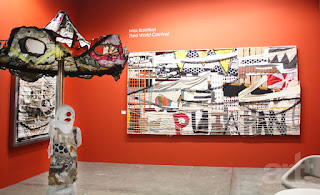Welcome to the Third World Carnival
Contributing writer Marz Aglipay interviews Can Yavuz of Yavuz Gallery, a Singapore-based gallery that exhibited Max Balatbat and Winner Jumalon at Art Stage Singapore.
At this year’s Art Stage Singapore, Yavuz Gallery opted to present a solo exhibition by Max Balatbat and a large-scale work by Winner Jumalon. It shows growing regard for Balatbat and Jumalon—two Filipino artists were chosen from the gallery’s roster of Southeast Asian artists. We spoke with gallery founder Can Yavuz about how they came up with their show.
How did you come to represent Max Balatbat and Winner Jumalon?
Can Yavuz: We have been representing Winner Jumalon since late 2013, and have shown his works in art fairs in Singapore and internationally, as well as in a 2015 solo exhibition at our gallery.
We have only recently started working with Max, who is one of the most exciting Filipino artists of his generation. We have known about him for many years following his recognition at the 2009 Florence Biennale when he was awarded the prestigious Lorenzo il Magnifico award.
Why did you choose to present Max Balatbat’s Third World Carnival at Art Stage Singapore?
CY: This was the first of many more projects to come with Max. The message and story of Third World Carnival is an important one that needed to be told.
Did the gallery give a creative directive for either of the artists’ works for this year’s fair?
CY: We actually did not give any creative directives for the artists (we never do), aside from notes on how much space they could work with—Winner’s work, for example, was necessarily a mural-sized piece, as the wall we were provided with was 9 meters long. I knew the styles and themes that both Max and Winner’s works typically explore, and so gave them the freedom to create their works as they wanted to.
What was the response to the works of Filipino artists?
CY: We found the response very positive, and did very well at the fair. We were able to place works in collections in Singapore, the Philippines, Indonesia, Hong Kong, and the Middle East. Singaporean and Southeast Asian collectors are not unfamiliar with Filipino art and artists. The audience was moved in particular by Max’s story behind his sculpture “Sampaghija” and the love he has towards the people and neighborhood in Caloocan City that he grew up in.
Balatbat’s Third World Carnival is driven by mixed media works based on a narrative of his life in the red-light district of Caloocan City. The defining piece, “Sampaghija,” is a sculpture of a young girl leaning on the center pole of a merry-go-round. She holds out a string of Sampaguita flowers. Her underwear hangs around her calves, suggesting exploitation. The sculpture was first featured in Balatbat’s Avenida Karnabal exhibition at Ayala Museum’s Artist Space in July 2015.
Jumalon’s work, “Forgetting Myself,” is a triptych mural depicting nude images. The work was included in Art Stage Singapore’s display of public artworks.
Read about Filipino artists who were shown at Art Stage Singapore in the current issue of Art+ (issue #43).
Photo by Marz Aglipay. Originally Published on artplus.ph

Comments